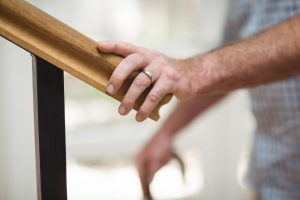 As we get older, we must become more and more mindful of our surroundings and take necessary precautions to prevent accidents and injuries. Stair safety requires particular attention because stairs can cause significant and even life-threatening injuries. Fortunately, there are several stair safety tips for seniors that can reduce the risk of falling and keep everyone all safer in your home.
As we get older, we must become more and more mindful of our surroundings and take necessary precautions to prevent accidents and injuries. Stair safety requires particular attention because stairs can cause significant and even life-threatening injuries. Fortunately, there are several stair safety tips for seniors that can reduce the risk of falling and keep everyone all safer in your home.
Top Stair Safety Tips for Seniors
Install sturdy handrails on both sides of staircases.
Handrails provide added support and stability for anyone using stairs, but they are vital for seniors who may have difficulty balancing or walking up and down stairs. Handrails shouldn’t be limited to one side of the staircase, though. Instead, they should be installed on both sides so you can use whichever hand is most comfortable. Once you have them securely anchored to the wall, you should check them periodically for signs of wear and tear.
Keep stairs clear of clutter and debris.
Objects left on stairs can be a tripping hazard. To avoid falls, you should clear your stairs of clutter and remove any items that could cause you to trip, such as shoes, books, or loose carpeting. Consider using a basket or other container to collect things that need to be carried up or down and place it at the bottom of the stairs.
Ensure that stairs are well-lit.
Good lighting is essential for stair safety. Make sure your stairs are well-lit so you can see where you’re going. You can install bright lights at the top and bottom of the staircase, LED lights that line each step, or motion-sensor lights that turn on automatically when someone approaches.
Install non-slip treads on each step.
Non-slip treads are an effective way to prevent slips and falls on uncarpeted stairs. They provide extra traction and grip, even in wet or slippery conditions. Non-slip treads can be made of rubber or other materials and installed directly onto the stairs or attached with adhesive strips.
Consider installing a stairlift or ramp if necessary.
If you have difficulty with stairs, consider installing a stairlift or ramp. A stairlift is a motorized chair that rides along a track attached to the stairs, while a ramp is a sloping surface that allows you to walk up or down without using stairs. Both devices can make getting up and down more manageable, especially if you have mobility issues or use a wheelchair.
Take your time walking up or down the stairs.
An essential part of stair safety is taking your time to go up and down. There is never a need to hurry. Even if you’re running late, safety is always more important than a schedule.
Use a cane for added support.
If you have difficulty balancing or walking up and down stairs, consider using a cane for support. It can provide additional stability and balance and help prevent falls when used in tandem with a handrail. Make sure you adjust it to the correct height, and use it on every step.
Wear proper footwear with a good grip.
Wearing shoes with a good grip is essential for stair safety. Choose shoes with a non-slip sole and a low heel, or consider wearing sneakers or athletic shoes with good arch support. Avoid wearing shoes with slick soles or high heels, which can be unstable on stairs for people of any age.
Additional Stair Safety Tips
There are more generic safety measures seniors can take to reduce their risk of falling too. Regular exercise and maintaining good balance are essential for staying steady on your feet. The CDC recommends that older adults do at least 150 minutes of moderate-intensity aerobic activity per week, such as brisk walking, cycling, or swimming, in addition to muscle-strengthening exercises two or more days a week.
It’s also important to have regular eye exams, as vision problems can increase your risk of falling. Poor vision can make it harder to see obstacles or judge distances, especially in dimly lit areas. Be cautious when taking medications that can affect balance or cause dizziness, and keep emergency contact information handy.
At Lighthouse Senior Living, we understand the importance of stair safety for our residents. Our staff is trained to assist residents with mobility issues, and our community is designed with the health and safety of our residents in mind. If you or a loved one are considering senior living options, contact us today to learn more about our services.
Stair safety is crucial for seniors. By following these tips and taking other safety measures, you can reduce your risk of falling and stay healthy and independent for years to come.
